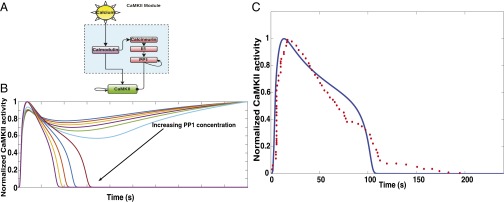Fig. 3.
(A) CaMKII module: CaMKII is activated by Ca2+–calmodulin. Calmodulin also activates an ultrasensitive phosphatase cascade, which includes calcineurin, Il1, and PP1. As a result, the temporal dynamics of CaMKII activation is tightly regulated by both Ca2+–calmodulin-led CaMKII autophosphorylation and PP1-mediated dephosphorylation. (B) The coupling between the phosphatase cascade and the autophosphorylation events results in a bistable response of CaMKII. The different curves in the plot are CaMKII dynamics in response to increasing PP1 concentration. PP1 concentration was varied from 0 to 1 μM. Increasing PP1 concentration results in switching from sustained CaMKII activation to transient CaMKII activation. (C) In our model, PP1 initial concentration of 0.36 μM results in CaMKII dynamics that matches closely with experimental data. The blue solid line is the simulation data, and the red filled circles are the experimental data. The experimental data were extracted from figure 1D in the work by Murakoshi et al. (16). The rms error was 0.11 for n = 63 data points from experiments.

